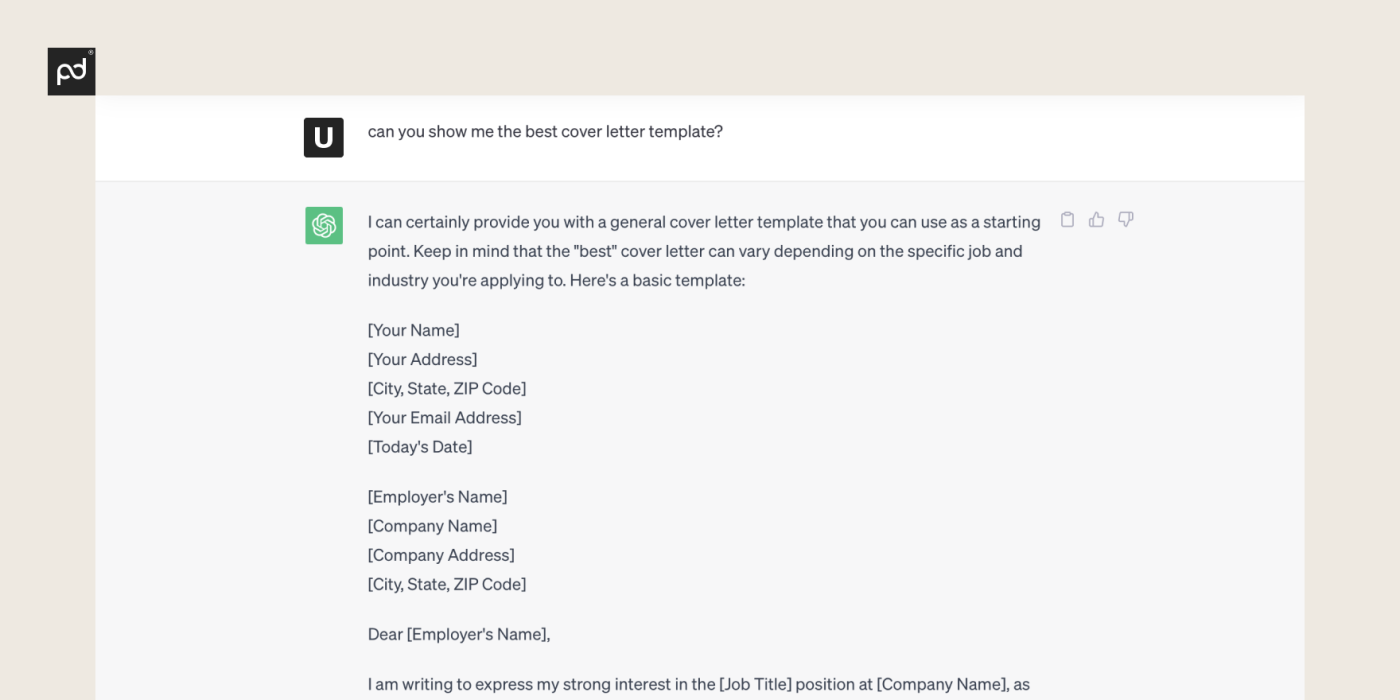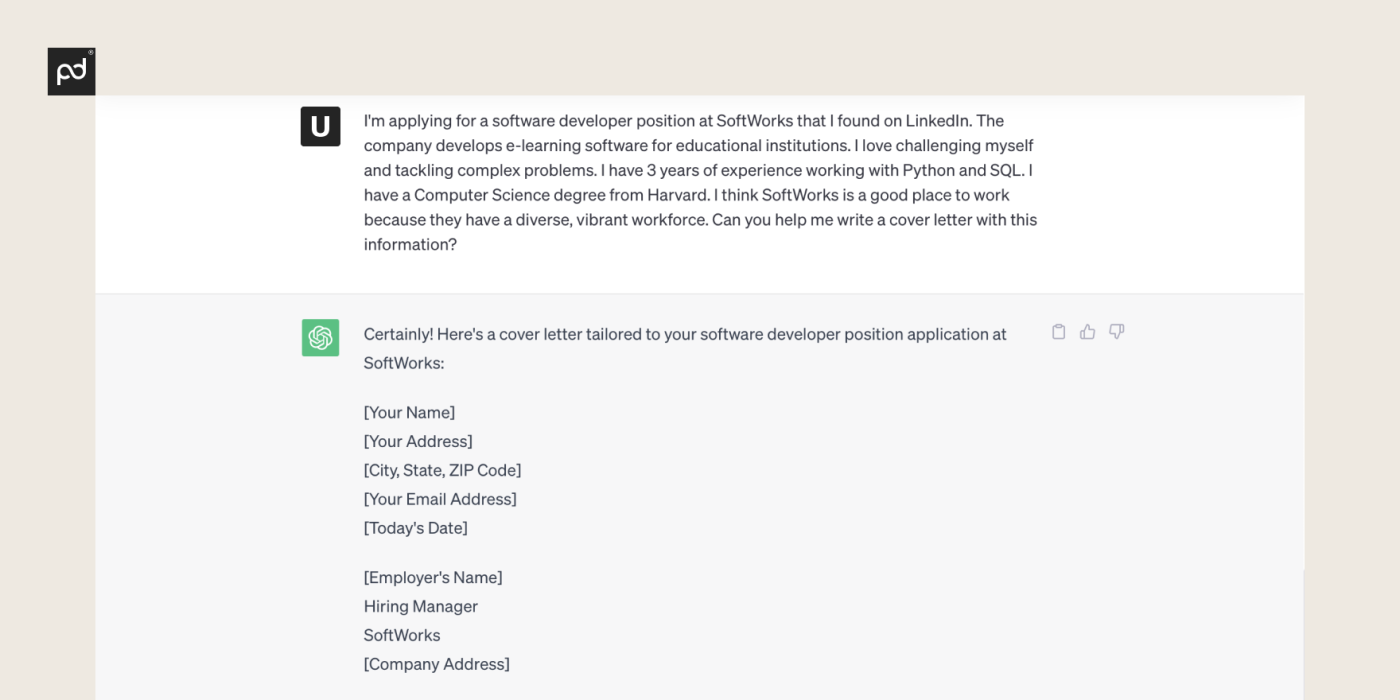How to use ChatGPT to write a cover letter
Before asking OpenAI’s ChatGPT to help you with your cover letter, you must know which of your best characteristics match the job requirements.
This will help you generate a detailed set of prompts for ChatGPT.
To write a cover letter with ChatGPT, you must do the following:
- Extract information from the job description and the company’s info.
- Create a personalized prompt with your qualifications.
- Generate a response from ChatGPT.
- Personalize to your satisfaction.
Follow this step-by-step process to generate high-specificity prompts for writing a cover letter using ChatGPT.
Step 1. Pay attention to the job description
Before even typing one word for your cover letter, you have to first go to the job posting and read the entire description, starting from the job title.
This will give a better understanding of the role, its expectations as well as offer vital bits of information.
Let’s say you want to apply for a software developer job at SoftWorks posted on LinkedIn.
The first thing to do is thoroughly research the company, focusing on their culture, values, ongoing projects, and reputation in the job market.
You should also go to their press releases and social media channels to find out how they position themselves and how it aligns with your desires and needs.
With all this information, you will arm yourself with enough information to write a letter that highlights all your best qualities and pushes you further up the queue.
Step 2. Gather information from the best templates
When writing a cover letter, you should check what has been working for other job seekers.
You can find a properly-written cover letter template online to help you understand the dos and don’ts.

You can visit chat.openai.com to ask ChatGPT for a good cover letter template.
The chatbot will run your question through multiple algorithms and language models to create a generic template.
But the thing is, you don’t want a generic cover letter for your CV, as this would defeat the entire purpose of writing one.
You want something memorable and personal.
Step 3. Create personalized prompts for ChatGPT
Short, generic prompts won’t cut it when working with ChatGPT.
You need to create multiple, detailed ChatGPT prompts tailored to the specific role, job description, company’s direction, and your qualifications.
Here are examples of both a bad prompt and a good prompt.
Bad prompt: Can you create a cover letter for a software developer role for me?
The prompt above doesn’t work because it only gives you a cover letter that everyone else on the internet could be using.
After all, the information comes from the same language models and public databases.
Alternatively, you need to create a prompt that ticks the following boxes:
- Your current role — employed, unemployed, employed but searching, recently graduated.
- Your career goals and fields of interest.
- The position you are applying for — mention the exact name in the job posting.
- Your motivation to apply and why the company meets those expectations.
- Your core skills that relate to the target role.
- Your work experience in the role or similar jobs.
Excellent prompt: I’m applying for a software developer position at SoftWorks that I found on LinkedIn. The company develops e-learning software for educational institutions. I love challenging myself and tackling complex problems. I have 3 years of experience working with Python and SQL. I have a Computer Science degree from Harvard. I think SoftWorks is a good place to work because they have a diverse, vibrant workforce. Can you help me write a cover letter with this information?

The output will look something like this screenshot.
Now, you can see that even though this letter is passable it still lacks personality and significant “oomph” to truly stand out.
Step 4. Personalize the letter further
You have your first output; next, you need to add that personal touch to get your cover letter to completion.
This part is essential because AI-generated content can sound robotic and predictable.
Besides, most recruiters now run cover letters through AI detectors.
So, if your cover letter gets popped for AI-generated text, you will automatically be out of the running for the position.
You should consider some ChatGPT plugins to write your CV and fine-tune your cover letters.
They’ll also help you convert the output text into any format, including XLS, DOCX, PDF, and HTML.
You can also use other plugins and AI tools that use natural language processing to get rid of robotic-sounding sentences.
Once done, look everything over.
Does it flow smoothly, highlighting both your enthusiasm and individuality? If the answer is yes — congratulations!
You now have a personalized cover letter for your dream job.
Step 5. Add finishing touches
With the draft ready, you need to finalize the application process.
First, go back to the job description to see if you’ve covered every important detail in your cover letter. Sometimes, the posting will contain little “Easter eggs” for applicants.
Recruiters value attention to detail, so getting everything right gives you an effective cover letter.
After that, proofread the letter and review the grammar to eliminate errors.
Grammarly can help you with this process. And don’t forget to add your contact information!
Once you are satisfied with the final output, you can now submit the cover letter with your CV and hope for a response from the hiring manager.
Write great cover letters with PandaDoc
Writing cover letters for multiple job applications could quickly become a daunting task if you don’t have a guide.
You need to understand the job requirements and use a cover letter generator as a starting point.
That’s why you should get templates from a trusted document management solution.
PandaDoc provides you with templates for writing a CV or creating personalized job proposals.
You can also use the built-in text editor to write a compelling cover letter from scratch.
The best part is that you can use the artificial intelligence assistant Panda AI to generate responses to prompts for many job applications.
This virtual assistant is a perfect substitute for ChatGPT because it works directly in the document editor.

